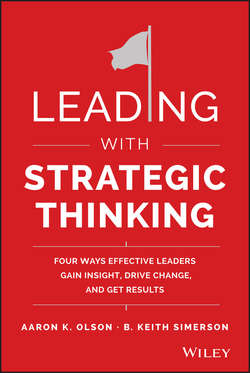Читать книгу Leading with Strategic Thinking - Olson Aaron K. - Страница 5
На сайте Литреса книга снята с продажи.
FOREWORD
ОглавлениеDisruptive change requires a new type of strategic leadership. While it is hard to define, we know what it looks like when we see it and when we don't. This book creates a new lexicon for this critical skill set and actionable ideas on how to develop a strategic perspective, apply adaptive thinking, and demonstrate courageous leadership.
A good example of the complex challenges we face is health care. It's clear that the traditional way of delivering health benefits – and health care – is broken. Costs continue to rise unabated, and the health of the population continues to decline. Nowhere is this more acute than in the United States. For the first time in decades, key stakeholders from employers, to insurance carriers, to health care providers, to government are all working on ways to fix a system that is ripe for fundamental change. In my recent discussions with literally hundreds of government leaders, CEOs in the health care industry, and senior executives at some of the world's largest employers, they are all trying to make sense of their role in an evolving health environment. They must rethink their definition of health and performance, reexamine the strength of the implied contract for health between employers and employees, and reconsider their role in transforming the health ecosystem in ways that align risk and consequences and drive healthy behaviors and outcomes.
This is just one example of a new breed of disruptive forces that are fueling upstarts and challenging incumbents in almost every industry and economy around the world. Advances in technology are transforming every aspect of our lives – enabling new solutions, services, and products delivered in a highly personalized way. The rise of consumerism is giving new power to the individual and raising expectations for the information and access needed to make increasingly consequential choices that affect our security and well-being. Likewise, globalization is creating both opportunity and competition as people and countries become increasingly intertwined.
Navigating these kinds of systemic change requires strategy and leadership. Finding the right solutions will require strategic analysis, design, and planning. Driving the necessary change will require strong leadership that embraces diverse thought, builds trust, creates momentum, and removes barriers. Without both strategy and leadership, we risk making incremental progress that doesn't address the real underlying problems we face.
The urgent need for strategic leadership exists at every level. We need leaders who can see opportunities arising from complex, highly interdependent problems. We need frontline leaders who can lead the charge, influencing others to embrace new ways of working together – and working for one another to achieve a common mission. We need individuals who are motivated to reinvent their own work and equipped to make trade-offs between competing priorities without constant direction from above.
Strategic leadership is easy to recognize when it is present – or missing – but it is often hard to describe. I've worked with many leaders in my career who possess the ability to assess an environment and quickly adapt their approach to suit the situation. I've probably worked with more who were unable to deconstruct a challenge, consider alternatives and consequences, and work differently to get the desired results. I've realized that the best leaders see patterns that others don't and can turn these observations into unique actions. They enroll and empower those around them to actively participate in problem solving. Most importantly, they aren't afraid to seek feedback and make course corrections when needed along the way. This book helps motivate, develop, and support individuals and organizations to bring together strategic thinking and strong leadership.
Aaron and BK offer fresh and pragmatic insights into what it means to approach a problem strategically and then lead through the required change. I've enjoyed spending time with them sharing some of my real-life examples of what strategic leaders actually do when addressing real-world problems and opportunities. As teachers, coaches, and leaders themselves, they've used their own experiences, along with insights from their deep networks, to capture crucial aspects of strategic leadership in practical terms that are easy to understand and apply. The result is a new and powerful language on how to lead through strategic change.
I look forward to seeing this book help organizations and individuals lead more strategically and with more sustainable impact.
– Kristi Savacool
CEO, Aon Hewitt
